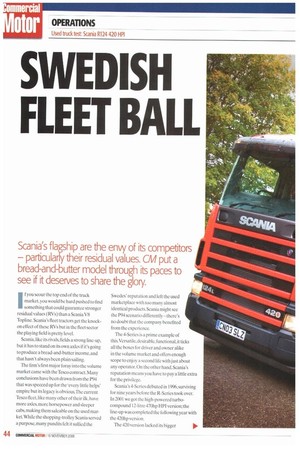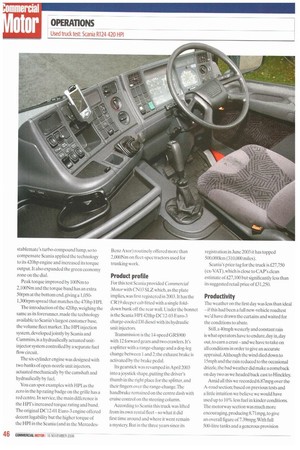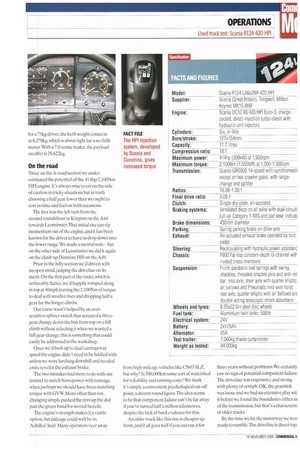SWEDISH FLEET BALL
Page 44

Page 46

Page 47

Page 48

If you've noticed an error in this article please click here to report it so we can fix it.
Scania's flagship are the envy of its competitors
— particularly their residual values. CM put a
bread-and-butter model through its paces to see if it deserves to share the glory.
If you scour the top end of the truck market, you would be hard pushed to find something that could guarantee stronger residual values (RVs) than a Scania V8 Topline. Scania's fleet tractors get the knockon effect of these RVs but in the fleet sector the playing field is pretty level.
Scania. like its rivals, fields a strong line-up, but it has to stand on its own axles if it's going to produce a bread-and-butter income, and that hasn't always been plain sailing.
The firm's first major foray into the volume market came with the Tesco contract. Many conclusions have been drawn from the P94 that was specced up for the 'every little helps' empire but its legacy is obvious. The current Tesco fleet, like many other of their ilk, have more axles, more horsepower and sleeper cabs, making them saleable on the used market. While the shopping-trolley Scania served a purpose, many pundits felt it sullied the Swedes' reputation and left the used marketplace with too many almost identical products. Scania might see the P94 scenario differently — there's no doubt that the company benefited from the experience.
The 4-Series is a prime example of this.Versatile,desirable, functional, it ticks all the boxes for driver and owner alike in the volume market and offers enough scope to enjoy a second life with just about any operator. On the other hand. Scania's reputation means you have to pay a little extra for the privilege.
Scania's 4-Series debuted in 1996, surviving for nine years before the R-Series took over. In 2001 we got the high-powered turbocompound 12-litre 470hp HPI version;the line-up was completed the following year with the 420hp version.
The 420 version lacked its bigger stablemate's turbo-compound lump, so to compensate Scania applied the technology to its 420hp engine and increased its torque output. It also expanded the green economy zone on the dial.
Peak torque improved by 100Nm to 2,100Nm and the torque band has an extra 50rpm at the bottom end, giving a 1,0501,30Orpm spread that matches the 470hp LIP!.
The introduction of the 420hp, weighing the same as its forerunner, made the technology available to Scania's largest customer base, the volume fleet market.The HP! injection system, developed jointly by Scania and Cummins, is a hydraulically actuated unitinjector system controlled by a separate fuel flow circuit.
The six-cylinder engine was designed with two banks of open-nozzle unit injectors. actuated mechanically by the camshaft and hydraulically by fuel.
You can spot examples with HP1 as the zero in the hp rating badge on the grille has a red centre. In service, the main difference is the HP1's increased torque rating and hand. The original DC12-01 Euro-3 engine offered decent lugability but the higher torque of the HPI in the Scania (and in the Mercedes Benz Axor) routinely offered more than 2,000Nm on fleet-spec tractors used for trunking work.
Product profile
For this test Scania provided Commercial Moior with CNO3 SLZ which, as the plate implies, was first registered in 2003. It has the CR19 sleeper cab fitted with a single folddown bunk off the rear wall. Under the bonnet is the Scania HPI 420hp DC12-03 Euro-3 charge-cooled DI diesel with its hydraulic unit injectors.
Transmission is the 14-speed GRS900 with 12 forward gears and two crawlers. It's a splitter with a range-change and a dog-leg change between 1 and 2:the exhaust brake is activated by the brake pedal.
Its gearstick was revamped in April 2003 into a joystick shape, putting the driver's thumb in the right place for the splitter, and their fingers over the range-change.The handbrake remained on the centre dash with cruise control on the steering column.
According to Scania this truck was lifted from its own rental fleet —so what it did first time around and where it went remain a mystery. But in the three years since its registration in June 2003 it has topped 500,000km (310.000 miles).
Scania's price tag for the truck is f27,750 (ex-VAT), which is close to CAP's clean estimate of i27,100 but significantly less than its suggested retail price of £31,250.
Productivity
The weather on the first day was less than ideal — if this had been a full new-vehicle roadtest we'd have drawn the curtains and waited for the conditions to abate.
Still, a 40mph westerly and constant rain is what operators have to endure, day in,day out, to earn a crust — and we have to take on all conditions in order to give an accurate appraisal.Although the wind died down to 15mph and the rain reduced to the occasional drizzle,the had weather did make a comeback on day two as we headed back east to Hinckley.
Amid all this we recorded 6.87mpg over the A-road section: based on previous tests and a little intuition we believe we would have used up to 10% less fuel in kinder conditions. The motorway section was much more encouraging, producing 8.71mpg.to give an overall figure of 7.39mpg.With full 500-litre tanks and a generous provision for a 75kg driver, the kerb weight comes in at 8.378kg, which is about right for a no-frills motor. With a 7.0-tonne trailer, the payload on offer is 28,622kg.
On the road Twice on the A-road section we underestimated the potential of the 414hp/2,100Nm HPI engine. It's always wise to err on the side of caution in tricky situations but in truth choosing a half gear lower than we ought to cost us time and fuel on both occasions.
The first was the left turn from the second roundabout in Kington on the A44 towards Leominster.That initial rise can rip momentum out of the engine, and it has been known for the driver to have to drop down into the lower range. We made a mental note —but on the other side of Leominster we did it again on the climb up Dinmore Hill on the A49.
Prior to the hilly section we'd driven with an open mind,judging the driveline on its merit. On the first part of the route, which is noticeably [latter, we'd happily romped along in top at 40mph leaving the 2,100Nm of torque to deal with smaller rises and dropping half a gear for the longer climbs.
Our cause wasn't helped by an oversensitive splitter switch that actuated a threegear change down the box from top on a hill climb without selecting it when we wanted a full gear change; this is something that could easily be addressed in the workshop.
Once we'd built up to dual carriageway speed the engine didn't need to be fiddled with unless we were lurching downhill and needed extra revs for the exhaust brake.
The two mistakes had more to do with our instinct to match horsepower with tonnage, when perhaps we should have been matching torque with GVW. More often than not, changing simply pushed the revs up the dial past the green band for no real benefit.
The engine's strength makes it a viable option, but mileage could well be its Achilles' heel. Many operators veer away from high-mileage vehicles like CNO3 SLZ, but why? Is 500,000km some sort of watershed for reliability and running costs? We think it's simply a convenient psychological cut-off point, a decent round figure.The idea seems to be that component failure can't he far away if you've turned half a million kilometres, despite the lack of hard evidence for this.
An older truck like this one is cheaper up front, and if all goes well if you can run it for three years without problems. We certainly saw no sign of potential component failure The driveline was responsive and strong with plenty of oomph. OK, the gearstick was loose and we had an extensive play wit it before we found the boundaries either sil of the transmission, but that's a characteris of older trucks.
By the time we hit the motorway we wer ready to rumble.The driveline is direct top, and although the revs are closer to 1500rpm, the broad torque band means any climbs on the motorway can generally he tackled in top. Evidence of its strength in depth was provided by the hill climb past J1 on the M42 from the M5, where we reached the peak comfortably without dropping a cog.
Cab comfort When it comes to a fleet tractor, the less there is to damage, the better for the owner and carousel of drivers.The Scania's dark interior looked clean and free of the scuffs and scrapes usually associated with fleet trucks.
But the cab did show its age in terms of squeaks and rattles.The steering wheel sang like a canary when it was turned during tight manoeuvres. and as the test neared its end the pull-out drawer in the centre developed a small rattle.
Apart from that and a few serapes on the pa intwork, CNC/3 SLZ's overall condition was decent enough to warrant the asking price. The Spartan fleet look, favoured by many manufacturers these days, will allow its new owner to make his mark.
The passenger seat was pushed back to the rear wall and the space behind the driver's seat was ideal for bags and cases. There was one external locker on the driver's side — and a flat footwell, making it easy to retrieve anything lost en route, such as money, pens or the mobile.
























































































































































































